Jonathan Craig1, Jon Gluyas2, Cameron Laing3 and Philip Schofield4, commemorate Britain’s first onshore well, ahead of a major conference.
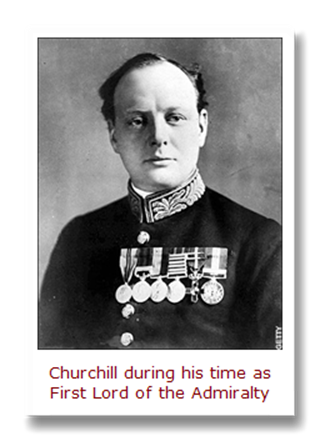 In 1911, as the storm clouds of war were gathering in Europe, Winston Churchill was appointed as First Lord of the Admiralty at the age of 36, giving him effective charge of the British Royal Navy and the British Grand Fleet. At this critical time in world history, Churchill (left) made the momentous decision to change the fuel used to power the Royal Navy’s ships from coal to oil.
In 1911, as the storm clouds of war were gathering in Europe, Winston Churchill was appointed as First Lord of the Admiralty at the age of 36, giving him effective charge of the British Royal Navy and the British Grand Fleet. At this critical time in world history, Churchill (left) made the momentous decision to change the fuel used to power the Royal Navy’s ships from coal to oil.
It was a brave decision – at the time, Britain had almost unlimited supplies of coal, but no indigenous supplies of oil whatsoever – and, in the opinion of most knowledgeable experts at the time, little chance that it ever would. Britain would have to rely entirely on importing foreign oil supplies, mainly from her vast empire, with Burma (then part of ‘British India’), Trinidad and, eventually, Persia supplying the ‘lion’s share’. Churchill’s decision was a mixed blessing – it gave the ships greater efficiency, speed and range, and helped alleviate the chronic shortage of manpower by reducing the need for that happy breed of men, known as ‘stokers’; but it left the Navy dangerously dependent on foreign oil supplies.
War
When Britain eventually declared war on German in 1914, it soon became clear that German submarines posed a significant threat to those oil supplies, as U-boats repeatedly attacked and sank tankers bringing essential oil supplies from the Indian Subcontinent, the Middle East and the Caribbean. By 1915, the British Government finally realized the scale of the threat and, in something of a panic, commissioned a company called S. Pearson and Sons to undertake a survey of potential oil resources in Britain. S. Pearson and Sons was owned by Lord Cowdray (S. Pearson became Lord Cowdray when he inherited the Cowdray Eastate, near Midhurst, West Sussex) and was heavily involved in the oil industry in Mexico through Cowdray’s Mexican Eagle Oil Company.
Pearson staff identified three main areas as having significant oil potential – the Lothians area in the Midland Valley of Scotland, together with the Potteries Region of Staffordshire and the Derbyshire Coalfield, both of which in, what is now, the ‘East Midlands Oil Province’. Eventually, after much debate, it was decide that the government would fund the drilling of 11 exploration wells – seven in Derbyshire, two in Staffordshire and two in Scotland – to evaluate the potential.
There is now little information available to indicate why particular drilling locations were selected, but it is clear that the combination of suitable geology, the location of surface anticlines and the presence of oil seeps in nearby coal mines – particularly in the Derbyshire Coalfield - were significant factors.
First drilling
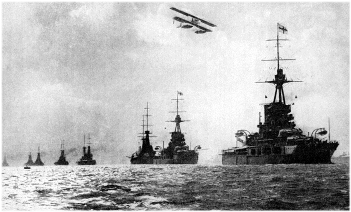 The first drilling location was on a prominent surface anticline in the Carboniferous Coal Measures at Hardstoft, near Tibshelf in Derbyshire, on land belonging to the Chatsworth Estate that was therefore (and, indeed, still is) owned by the Duke of Devonshire. In 1915, Lord Cowdray visited the offices of the Chatsworth Estates to obtain additional information about the local geology from the estate records, particularly concerning the local coal mines, and also to negotiate rights to drill for oil on the Duke’s land. It then took three and a half years to finalise the contracts required to allow the drilling to proceed. (Perhaps they didn’t realise there was a war on!) Eventually, on 10 September 1918, an agreement was signed with the Ministry of Munitions under which the drilling, supervised by staff under contract to S. Pearson and Sons, could begin.
The first drilling location was on a prominent surface anticline in the Carboniferous Coal Measures at Hardstoft, near Tibshelf in Derbyshire, on land belonging to the Chatsworth Estate that was therefore (and, indeed, still is) owned by the Duke of Devonshire. In 1915, Lord Cowdray visited the offices of the Chatsworth Estates to obtain additional information about the local geology from the estate records, particularly concerning the local coal mines, and also to negotiate rights to drill for oil on the Duke’s land. It then took three and a half years to finalise the contracts required to allow the drilling to proceed. (Perhaps they didn’t realise there was a war on!) Eventually, on 10 September 1918, an agreement was signed with the Ministry of Munitions under which the drilling, supervised by staff under contract to S. Pearson and Sons, could begin.
Picture - the British Grand Fleet 1914
At the time, Britain had absolutely no experience of drilling oil & gas wells, or equipment with which to drill them, so the derricks, all ancillary equipment and more than 50 drillers were shipped over from the United States to undertake the task.
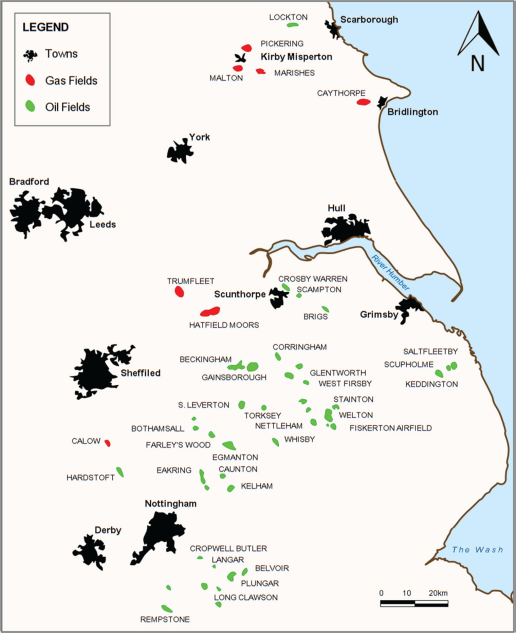 The Hardstoft No.1 well was eventually spudded on 15 October 1918 - by which time, of course, the war was virtually over! The spudding-in ceremony was attended by Lord Cowdray, the Marquess of Hartington (son of the Duke of Devonshire), together with representatives of the government and the oil industry.
The Hardstoft No.1 well was eventually spudded on 15 October 1918 - by which time, of course, the war was virtually over! The spudding-in ceremony was attended by Lord Cowdray, the Marquess of Hartington (son of the Duke of Devonshire), together with representatives of the government and the oil industry.
Image: Oil and gas fields in the east Midlands Oil Province (modified from Gluyas and Hichens 2003).
We actually know quite a lot about the equipment and the personnel involved in drilling Hardstoft No. 1, mainly from Chatsworth Estate records. It was drilled using the American cable system with the percussive tools that were standard at the time. An 85ft-high tubular steel derrick was constructed for handling tools and casing, complete with a 30 horsepower steam-driven drilling engine, powered by portable locomotive-type boilers.
The tools consisted of a rope socket, sinker bar, jars and a chisel-shaped bit. The well was ‘drilled’ by raising and dropping the bit into the hole and using a bailer with a self-shutting container to lift chippings out of the hole. In comparison with modern rotary drilling techniques, progress was painfully slow. The derrick and the associated equipment was almost certainly supplied by the Lucey Manufacturing Company, who described themselves as ‘Manufacturers of, and dealers in, Machinery & Tools for Rotary and Cable Drilling Systems, Tools, Supplies and Equipment for Oil, Gas, Water Wells, Pipe Lines and Refineries’.
Lucey maintained a branch office in London at the time. The well-site geologist for Hardstoft No. 1 was Mr Eugene Law Ickes - a graduate of the University of California. Mr Roderick Crandall from Stanford University was in charge of the ‘technical administration’ and the Drilling Superintendent was Victor L. Conaghan, from the U.S. Bureau of Mines. Ickes eventually returned to the United States in 1921 to work for the Standard Oil Company of California, while Crandall became a famous geologist in New York and worked subsequently in Russia and Brazil.
Hardstoft Dome
Hardstoft No.1 was drilled on the crest of the Hardstoft Dome – a faulted NW-SE trending anticline. It passed down through the Carboniferous Coal Measures, through the underlying Millstone Grit and Limestone shale and then, on the night of 27 May 1919 at a depth of 3,070ft, it struck oil in the top of the Carboniferous Limestone - in what subsequently turned out to be a rather small tilted fault block. As drilling continued, a possible oil-water contact was encountered at a depth of 3,112ft, indicating the presence of a c. 42ft oil column.
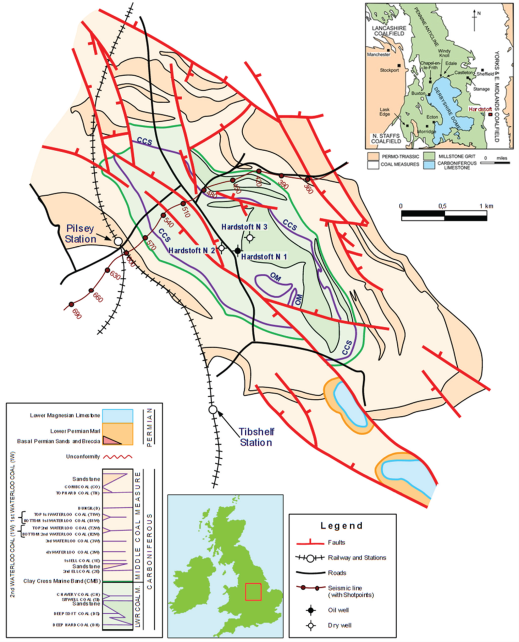 The first oil flowed from the well on 7 June 1919 and pictures of it appeared in that weeks’ edition of The London Illustrated News. On 25 June, it was announced in the House of Commons that the well was flowing at the prodigious rate of 11 barrels a day!
The first oil flowed from the well on 7 June 1919 and pictures of it appeared in that weeks’ edition of The London Illustrated News. On 25 June, it was announced in the House of Commons that the well was flowing at the prodigious rate of 11 barrels a day!
Image: Simplified geological map of the Hardstoft Dome, based on the Geological Survey of Great Britain (England & Wales) 1:63,360 scale Geological Map Sheet 112 Chesterfield, 1963. Location map modified from Gluyas & Bowman, 1997 (from Craig et al., 2013).
Two more wells were drilled on the Hardstoft anticline in the 1920s. Both encountered numerous drilling problems: No. 2 because it drilled through the main fault high up in the section, and No. 3 because it drilled through some old mine workings, and encountered a gas-bearing sand at 400ft (only discovered when the driller dropped a lighted match into the hole, causing an explosion) and finally, when the casing collapsed. No additional oil production was obtained from the two new wells, but some gas was found in sandstones within the shallower Coal Measures succession - this was used for several years to power the site.
Hardstoft oil was light and of good quality and, in fact, exceedingly ‘mature’. It was stored in a 12,000 barrel tank at the site and was initially transported by road to the nearby railway station at Pilsley and then, via the Great Central Railway, to the Pumpherston Refinery in Scotland. Eventually, a 4,500ft gravity-fed pipeline was laid directly from the well to Pilsley Station.
Between June 1919 and December 1927, the Hardstoft well produced about 20,000 barrels of oil at an average rate of six or seven barrels per day (b/d). It was originally intended to ‘shoot’ the well with nitroglycerin to stimulate production, until it was pointed out that the transportation of nitroglycerine over public roads in England was illegal.
Waxing
For the first four years, the well flowed under its own pressure, but was prone to waxing and silting. In 1921, the Government carried out a pump test that more than doubled the production from 7 b/d to 14.6 b/d, but the pumping was not continued because, since the Petroleum Production Bill that was put before Parliament in 1917 had not been approved, the government was not authorised to carry out commercial oil production.
The government had, in fact, originally used powers under the ‘Defence of the Realm Act’ to take the land necessary for the drilling, but this did not entitle it to produce and market the oil. Consequently, when the ‘Defence of the Realm Act’ was repealed at the end of the First World War, the Duke of Devonshire served an injunction on the British Government and, on 23 March 1923, took over the Hardstoft well, as he still owned the mineral rights and the land on which it had been drilled. Production Licence 1 in the U.K. Petroleum Licensing system, in which the Hardstoft Field is located, is still owned by the Duke of Devonshire and it is still the only licence in the UK not owned by the British Government.
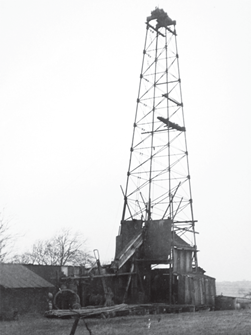 Picture: The Hardstoft No. 1 well, Tibshelf, Derbyshire. Source: Devonshire Mss., Chatsworth, Tibshelf/Hardstoft Oilwell papers.
Picture: The Hardstoft No. 1 well, Tibshelf, Derbyshire. Source: Devonshire Mss., Chatsworth, Tibshelf/Hardstoft Oilwell papers.
A ‘pump-jack’ was installed in 1924, but between 1924 and 1927 the Hardstoft well began to produce an increasing amount of water. At the time this was thought to indicate that the well was ‘watering-out’ as the bottom water encroached. By 1927 the production rate at fallen to such a low level that it was no longer worth selling the oil to the refinery, and the Chatsworth Estate instead used the unrefined oil to power a sawmill at nearby Hardwick Hall.
The well was put back into production in 1938, when Britain again found itself at war and in dire straits over the supply of foreign oil – having, apparently, learnt absolutely nothing from the situation during the First World War; but that is another, albeit equally fascinating story.
New importance
Interestingly, the story of the Hardstoft Field and its production history, nearly a hundred years after its discovery, has now assumed a new importance – much more than its meagre size would seem to warrant. This is because it is a key data point in the understanding of the tight oil and shale oil/shale gas play in the Carboniferous basins of Northern England. The Limestone Shale, penetrated by the Hardstoft well, known today as the Bowland Shale, is the main shale gas and shale oil exploration target in Northern England, while the equivalent of the Dinantian carbonate reservoir of the Hardstoft Field is currently undergoing a new phase of exploration in the southern North Sea. Re-evaluation of the Hardstoft Field, using seismic data acquired by BP in the mid-1980s and the available well logs, suggests that the field probably originally contained only about 170,000 barrels of oil in-place, of which some 29,000 barrels have been produced.
Image: Cross section through the Hardstoft Dome showing the location of the Hardstoft No.1 well (modified from Giffard, 1922).
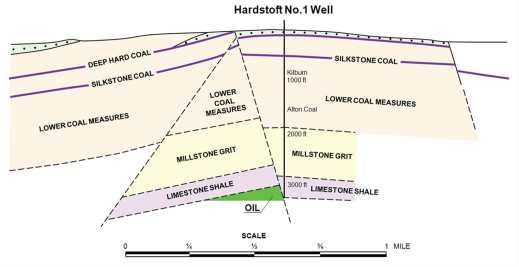
The Hardstoft No.1 well still exists today, along with the concrete base for the pump jack and the storage tank for the oil it produced carefully preserved and protected by the owner of the ‘Oilwell Nursery’ – a Garden Centre and plant nursery on the outskirts of the village of Tibshelf. In the United States, such an important historical site would a ‘National Monument’ – cherished, displayed and given the full protection of the law. In Britain, we rely on the generosity of a private individual to preserve what is, perhaps, our most important oil industry historical site. The fact that we do not take more care of, and more interest in, the early history of the UK oil and gas industry really is a disgrace.
Conference
Fortunately, the Geological Society intends to celebrate the Centenary of the Hardstoft Discovery – Britain’s first Oil Field – in May 2019. However, the celebration will start rather sooner, during a special conference on ‘European Oil & Gas Industry History’ at Burlington House on 3 and 4 March 2016, convened by the Geological Society Petroleum Group, the Geological Society History of Geology Group (HOGG) and the Petroleum History Institute. A fieldtrip to the ‘East Midlands Oil Province’ following the conference will include a visit to the Hardstoft No. 1 well site. Further details are available on the Geological Society website.
Authors
1. Eni Upstream & Technical Services, Via Emilia 1, 20097 San Donato Milanese, Italy, [email protected]. 2. Department of Earth Science, Durham University, South Road, Durham DH1 3LE, U.K. 3. Laing Engineering and Training Services Ltd., 63 Ness Circle, Ellon, Aberdeenshire, AB41 9BR, U.K. 4. Oilwell Nurseries, Chesterfield Rd., Tibshelf, Alfreton, Derbyshire, DE55 5NP, U.K.
- Jonathan Craig joined the oil & gas industry in the early 1980s and has worked for Geomorphological Services Ltd., Shell, LASMO and Eni on a wide variety of exploration and development projects, including assignments in Australia, Tanzania, Indonesia, Pakistan, Colombia, Venezuela, Libya and Italy. He is currently Senior Vice President, Exploration for Eni Upstream & Technical Services in Milan and is an Honorary Professor at University College London, the University of Durham and the University of Jammu in India.
- Jon Gluyas is a geologist with both petroleum industry and academic experience. He is currently Dean of Knowledge Exchange at Durham University as well as professor in Geoenergy, Carbon Capture and Storage. Prior to joining academia in 2009, Jon worked for 28 years in the petroleum industry, working around the globe for both multinational and independent sector oil companies. He co-founded Acorn Oil and Gas in 2001 and Fairfield Energy in 2005. Jon has published widely on oil field rehabilitation, sediment diagenesis and CCS. He authored the textbook ‘Petroleum Geoscience’ and has edited volumes on UK oil and gas fields, sediment diagenesis and CCS.
- Cameron Laing entered the oil industry 37 years ago after graduating as a Chemical Engineer from Heriot-Watt University. CL joined international operator Amoco in 1976 as a petroleum engineer, working in the UK, and later in the USA & Trinidad. From 1994 he spent 10 years with wells and subsurface consulting groups followed by 2 years at The Robert Gordon University helping develop and deliver a Petroleum Production Engineering M.Sc. Since 2007 he has run his own company specialising in artificial lift consulting and training. His special interests include: Artificial Lift; Production System Modelling; Completion Design; Well Integrity; – and Oilfield History!
- Philip Schofield was born in Sheffield and educated at Burngreave School. He has spent his career in the horticultural business in Derbyshire and bought the land on which the Hardstoft No.1 well was drilled more than 40 years ago. The deeds to the land are called 1 and 2 Oilwell Cottages and as he was looking for a name for his new nursery and garden shop, Phillip thought “Oilwell Nursery” was original and would be remembered by his customers. He is proud to be the custodian of such an important piece of Britain’s Industrial Heritage and the owner of the site of Britain’s first oilfield. Philip is always happy to show visitors around the Hardstoft site.
Further reading
- Brentnall, I. 1995. Britain’s first mainland oil well at Tibshelf/Hardstoft. Ashfield Historian 3(3), August 1995.
- Craig, J., Gluyas, J., Laing, C. and Schofield, P. 2013. Hardstoft – Britain’s First Oil Field. Oil-Industry History 14(1), 97-116.
- Giffard, H.P.W. 1922. The Recent Search for Oil in Great Britain. Transactions of the Institute of Mining Engineers LXV, 1922-23, 222-250.
- Wade, A. 1928. The oil well and later developments at Hardstoft, Derbyshire. Journal of the Institute of Petroleum Technologists 14, 357-387.